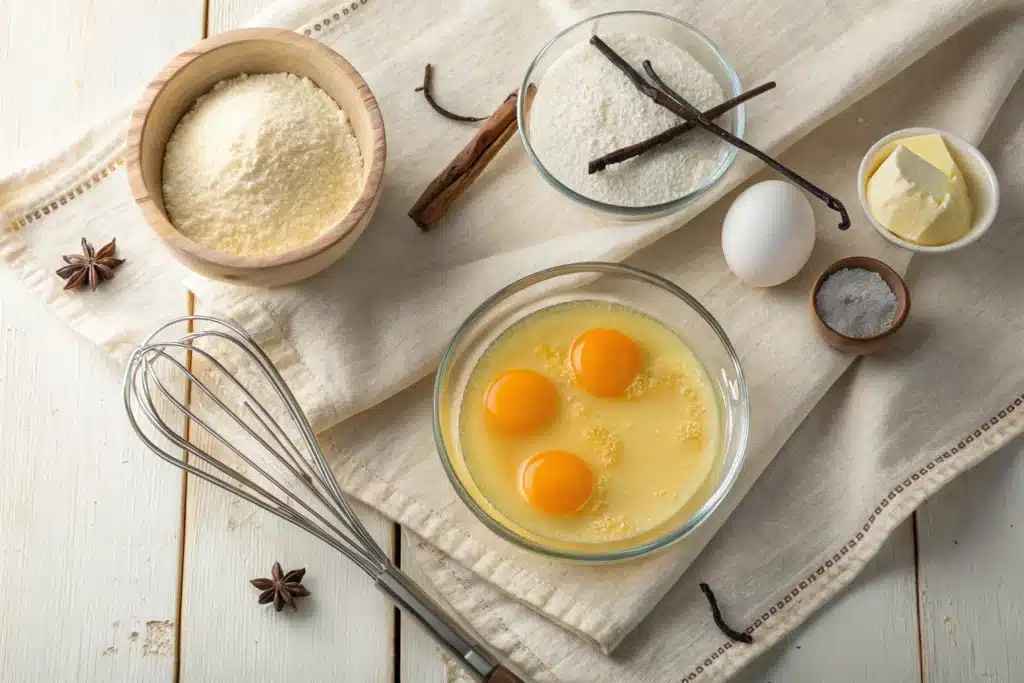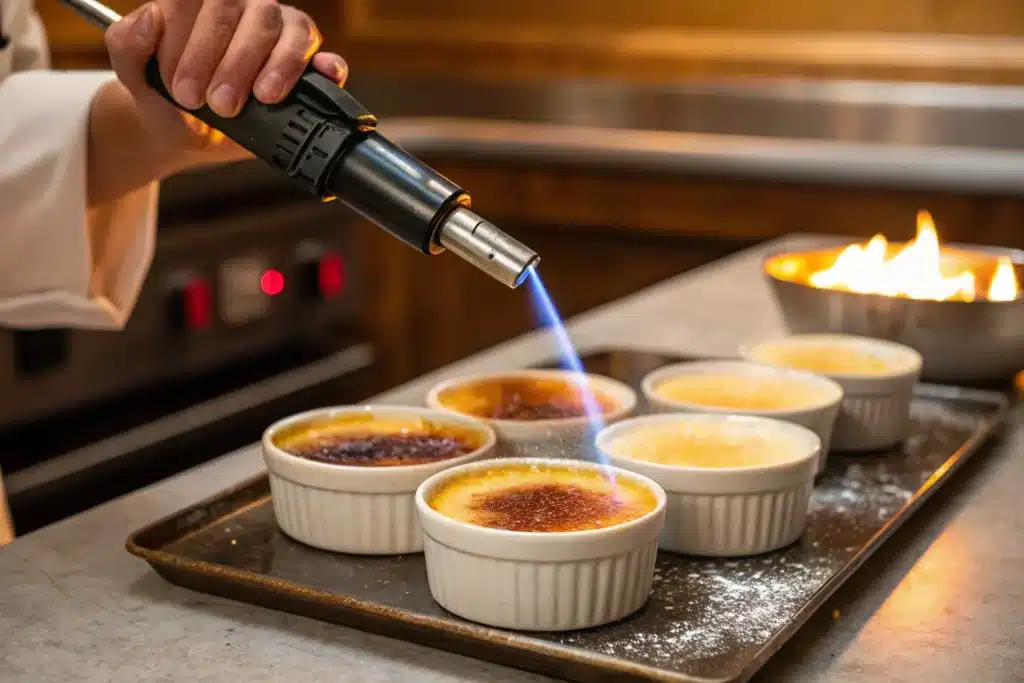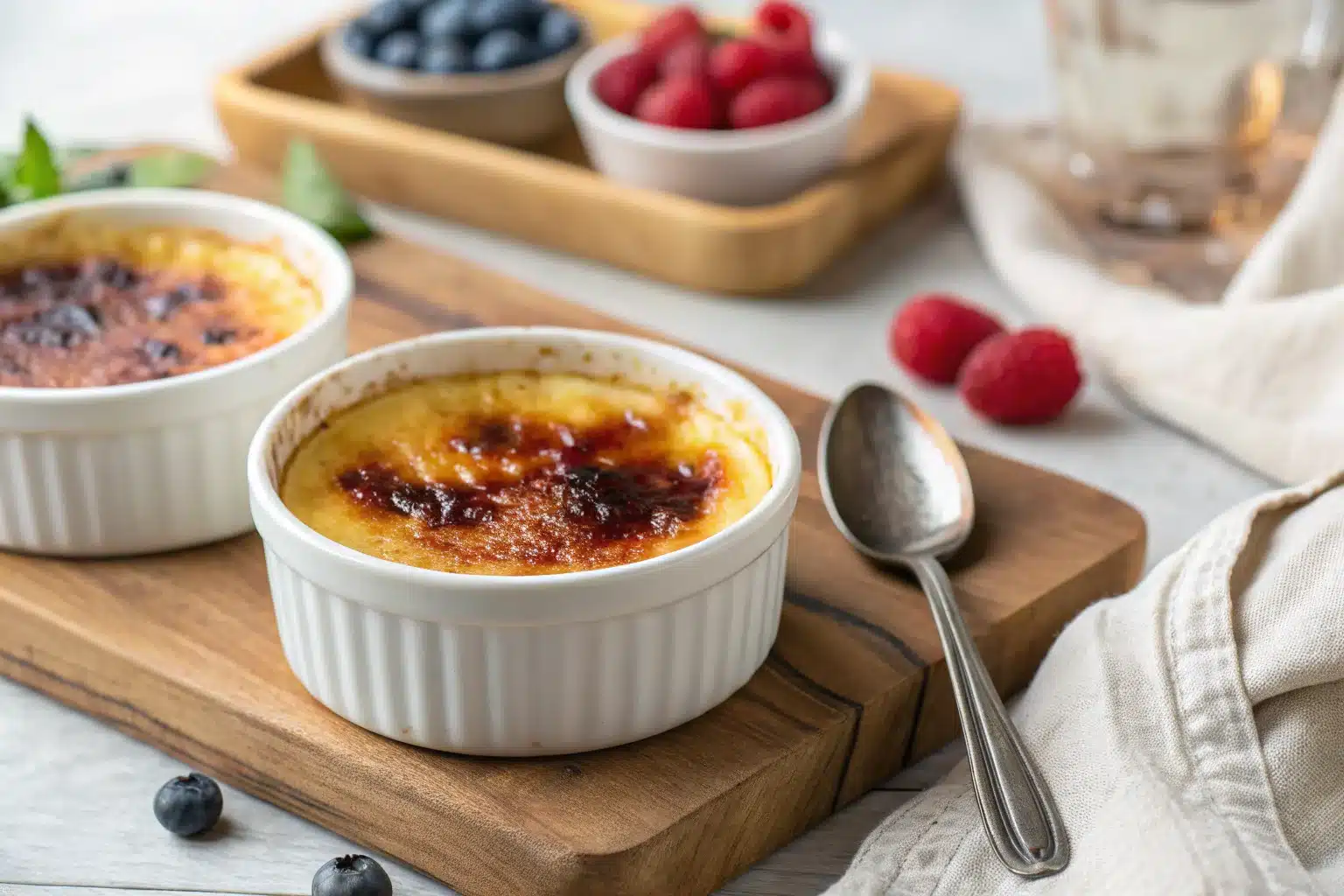Introduction
Crème brûlée is the epitome of elegance in the dessert world. With its silky-smooth custard base and that signature crackly caramelized sugar top, it’s no wonder this dish has stood the test of time. But what is the secret of crème brûlée? Why do some versions turn out flawlessly creamy while others become grainy or rubbery?
In this article, we’ll uncover the hidden techniques and best-kept secrets behind making the perfect crème brûlée. From its rich history to the science behind its texture, we’ll explore every detail. You’ll learn the essential ingredients, the importance of the bain-marie method, and even the best way to caramelize the sugar topping for that perfect crunch. Plus, we’ll go over common mistakes and creative variations to help you master this classic French dessert like a pro.
Let’s dive into the fascinating story of crème brûlée and its timeless appeal.
The Origins and History of Crème Brûlée
The First Appearance of Crème Brûlée
Crème brûlée might seem like the ultimate French dessert, but its origins are more mysterious than you’d think. While the name itself is French, there’s an ongoing debate about where it actually came from.
The French Connection: Is It Really French?
Many assume crème brûlée originated in France, and for good reason—it translates to “burnt cream” in French. The earliest known French reference dates back to François Massialot’s 1691 cookbook, where a similar custard dessert was described. However, some food historians believe that versions of crème brûlée existed long before in other countries.
A Look at Historical Recipe Books
In Catalonia, Spain, a dessert called crema catalana—which closely resembles crème brûlée—was made as early as the 14th century. The British also have a claim with Trinity Cream, served at Cambridge University in the 17th century. While these recipes differ slightly, the concept of a creamy custard with a caramelized top existed across Europe for centuries.
Crème Brûlée’s Evolution Through the Centuries
Over time, crème brûlée evolved, becoming a beloved dessert in fine dining and home kitchens alike.
The Influence of Spanish & British Custards
Spanish crema catalana is often flavored with cinnamon and lemon zest, while the British Trinity Cream was known for its torched sugar topping. French chefs refined the recipe, focusing on the balance between rich custard and crisp caramelized sugar.
Modern Takes on a Classic Dessert
Today, crème brûlée has taken on new forms with flavors like chocolate, matcha, and even lavender. Pastry chefs around the world experiment with different sugars for caramelization, from traditional white sugar to raw and demerara varieties. Despite these variations, the essence of crème brûlée remains timeless—a simple yet luxurious dessert with an irresistible texture.
The Essential Ingredients for the Perfect Crème Brûlée

Mastering crème brûlée starts with understanding its core ingredients. Each element plays a vital role in achieving the signature smooth custard and crisp caramelized topping. But what is the secret of crème brûlée when it comes to ingredients? It’s all about the balance of creaminess, sweetness, and flavor. Let’s break it down.
The Role of Heavy Cream and Egg Yolks
At its heart, crème brûlée is a custard-based dessert, and that means two key ingredients—cream and egg yolks—do most of the work.
Why Heavy Cream Is Non-Negotiable
Heavy cream gives crème brûlée its rich, velvety texture. Unlike milk or half-and-half, full-fat heavy cream ensures the custard sets properly without becoming watery or thin. The fat content stabilizes the eggs, preventing curdling and helping create a luxurious mouthfeel.
The Secret Function of Egg Yolks in Custard
Egg yolks aren’t just for thickening—their proteins help bind the ingredients together, creating a creamy, smooth consistency when baked gently. Too few yolks, and the custard is too loose; too many, and it turns overly firm. The right ratio is the key to perfection.
Sugar: More Than Just Sweetness
Sugar is essential in two ways: it sweetens the custard and forms the crunchy caramelized top. But choosing the right sugar can make all the difference.
Choosing the Right Sugar for Caramelization
Fine white sugar is the best choice for the caramelized topping because it melts evenly and forms a crisp, golden crust. Coarser sugars, like raw or turbinado, add texture but require more heat to melt properly.
How Sugar Affects the Texture
In the custard itself, sugar doesn’t just add sweetness—it also affects the texture. Too much sugar can prevent the custard from setting correctly, while too little makes it taste eggy. Finding the perfect balance is one of the secrets to a great crème brûlée.
Vanilla and Other Flavor Enhancements
Traditional crème brûlée relies on vanilla for its signature aroma, but modern variations explore new flavors.
Traditional Vanilla Bean vs. Extract
Using a whole vanilla bean instead of extract intensifies the flavor, creating a deeper, more aromatic custard. Vanilla extract works too, but it lacks the complexity of real vanilla specks infused in cream.
Experimenting with Unique Flavor Infusions
Want to take crème brûlée to the next level? Infusing the cream with ingredients like citrus zest, espresso, lavender, or even spices like cinnamon can create a unique twist on the classic dessert.
The ingredients of crème brûlée might be simple, but their quality and balance determine success. Next, we’ll uncover the secret techniques that make this dessert truly exceptional.
The Secret Technique Behind the Perfect Crème Brûlée

Beyond the ingredients, technique is everything when it comes to crème brûlée. Even with the finest ingredients, the wrong method can lead to curdled custard or a soggy sugar topping. What is the secret of crème brûlée when it comes to preparation? It’s all about patience, precision, and understanding the science behind the process.
The Bain-Marie Method: The Key to Smooth Custard
One of the biggest mistakes people make when baking crème brûlée is skipping the water bath. The bain-marie method ensures gentle, even cooking.
Why a Water Bath Prevents Curdling
A direct oven heat source can cause the eggs in the custard to cook too quickly, leading to an unpleasant, scrambled-egg texture. A bain-marie—placing the ramekins in a tray filled with hot water—helps regulate temperature and prevents overheating.
Temperature Control: Slow and Steady Wins the Race
A low oven temperature (around 300°F) is crucial. Baking too hot or too fast results in a grainy texture instead of a silky-smooth custard. A perfectly cooked crème brûlée should jiggle slightly in the center when gently shaken.
The Right Way to Torch the Sugar Topping
Caramelizing the sugar topping is the final touch that gives crème brûlée its iconic contrast of textures.
Choosing the Best Torch for the Job
A kitchen torch provides the best control, allowing you to melt the sugar evenly. Some people use a broiler, but this method often results in uneven caramelization or a melted custard underneath.
Getting the Perfect Caramelized Crunch
To achieve that classic “crack,” evenly sprinkle a thin layer of sugar over the custard before torching. Move the flame in small circles, keeping it a few inches away to avoid burning the sugar too quickly. The goal is a deep amber color with a crisp, glass-like texture.
Common Mistakes to Avoid
Even experienced bakers can run into trouble when making crème brûlée. A tiny misstep can result in a runny custard, a grainy texture, or an overly bitter caramelized topping. If you want to master what is the secret of crème brûlée, knowing what not to do is just as important as following the right steps.
Overcooking and Its Consequences
Overcooking crème brûlée is one of the biggest mistakes you can make. The custard should be just set, with a slight jiggle in the center.
Identifying the Right Consistency
If the custard is rock-solid or dry, it’s been in the oven too long. The goal is a smooth, silky texture—firm enough to hold its shape but soft enough to melt in your mouth. If your crème brûlée turns out rubbery, reduce your baking time and check for that characteristic wobble in the middle.
Avoiding Grainy Texture
A grainy or scrambled-egg-like texture happens when the custard curdles due to high heat or improper mixing techniques.
Proper Mixing Techniques
When combining the egg yolks and sugar, whisk gently rather than vigorously to prevent adding too much air. Slowly add the heated cream while whisking continuously to avoid cooking the eggs prematurely.
Temperature Control Tips
Use a thermometer to monitor your oven temperature. Some ovens run hotter than the setting indicates, leading to curdling or overcooking. If necessary, bake at a lower temperature and extend the time slightly to ensure gentle cooking.
Mastering these techniques will help you avoid common pitfalls and bring you closer to creating the perfect crème brûlée. But what about adding a creative twist? Let’s explore unique flavors and variations in the next section.
Variations and Flavor Twists
Classic crème brûlée is undeniably delicious, but why not experiment with exciting flavors? Once you understand what is the secret of crème brûlée, you can start playing with different ingredients to create unique versions of this timeless dessert.
Popular Flavor Infusions
By infusing the cream with different ingredients before baking, you can elevate crème brûlée with bold new flavors.
Chocolate and Coffee Crème Brûlée
Chocolate lovers can mix melted dark chocolate into the custard for a rich, decadent twist. For coffee enthusiasts, adding espresso powder or steeping coffee beans in the cream will create a bold mocha flavor.
Fruit-Infused Versions
For a lighter, fruitier version, try infusing the cream with citrus zest (like orange or lemon) or steeping fresh berries. A raspberry-infused crème brûlée offers a tangy contrast to the sweet custard.
Modern Twists and Experimentations
Crème brûlée has evolved far beyond its traditional vanilla flavor.
Vegan and Dairy-Free Alternatives
For those avoiding dairy, coconut milk or almond milk can replace heavy cream. Instead of egg yolks, cornstarch or agar-agar can be used as a thickener to create a plant-based custard.
Unconventional Toppings
While the caramelized sugar topping is iconic, some chefs take it a step further. A sprinkle of flaky sea salt, a dusting of cocoa powder, or even a drizzle of liqueur can enhance the flavor profile.
Once you’ve perfected your favorite crème brûlée flavors, it’s time to think about presentation. Let’s move on to how to serve and garnish your masterpiece!
Serving and Presentation Tips
A perfectly made crème brûlée deserves a presentation that highlights its elegance. Understanding what is the secret of crème brûlée isn’t just about technique—it’s also about how you serve it. From dishware choices to beautiful garnishes, these tips will elevate your dessert to restaurant quality.
Choosing the Right Dishware
The dish you serve crème brûlée in affects both its appearance and cooking time.
Traditional Ramekins vs. Contemporary Alternatives
Classic shallow ramekins are ideal because they allow for a higher custard-to-caramel ratio and even cooking. If using deeper dishes, adjust your baking time accordingly. For a modern twist, serve crème brûlée in espresso cups or small glass jars for a chic, individual portion.
Garnishing Ideas
While crème brûlée is already stunning on its own, a few well-placed garnishes can add color and contrast.
Using Fruits and Edible Flowers
Fresh berries like raspberries or blueberries complement the custard’s richness. Edible flowers, such as violets or pansies, add an elegant touch.
Pairing with Complementary Desserts
Pair crème brûlée with buttery shortbread cookies or a light fruit sorbet to balance its creaminess. A small glass of dessert wine or espresso makes an excellent accompaniment.
With presentation mastered, let’s answer some of the most common crème brûlée questions.
You can descover Leftover Rotisserie Chicken Recipes
FAQs
Crème brûlée is simple in theory but requires precision. Here are answers to the most common questions people ask when attempting this iconic dessert.
Why Is My Crème Brûlée Not Setting Properly?
If your custard is too runny, it may be undercooked. Bake until the edges are firm but the center has a slight jiggle. Also, ensure you’re using the correct egg yolk-to-cream ratio—too much cream can prevent it from setting.
Can I Make Crème Brûlée Ahead of Time?
Yes! You can prepare the custard up to 48 hours in advance and store it in the fridge. However, wait until just before serving to torch the sugar topping for the best crunch.
Which Torch Is Best for Caramelizing Crème Brûlée?
A kitchen torch with an adjustable flame works best. Butane torches are popular for even caramelization without heating the custard too much.
Is It Possible to Make Crème Brûlée Without a Torch?
Yes! If you don’t have a torch, use your oven’s broiler. Place the ramekins on the top rack and watch closely as the sugar caramelizes. Rotate them as needed for even browning.
Now that we’ve covered everything from technique to troubleshooting, let’s wrap up with a final recap.
Conclusion
So, what is the secret of crème brûlée? It’s a combination of quality ingredients, precise technique, and careful caramelization. From choosing the best vanilla to mastering the perfect custard texture, every step plays a role in achieving this classic dessert’s irresistible appeal.
Whether you stick to tradition or experiment with bold flavors, crème brûlée remains a timeless favorite. Avoiding common mistakes, using proper cooking methods, and paying attention to presentation will ensure your crème brûlée turns out flawless every time.
Now, it’s time to put these tips into practice! Grab your ingredients, preheat your oven, and get ready to create a dessert that’s smooth, creamy, and perfectly caramelized. Happy baking!
Explore more about this iconic dish and its creative twists by checking out What Is Crème Brûlée Mostly Made Of? and Crab Brûlée Recipes for inspiration!

